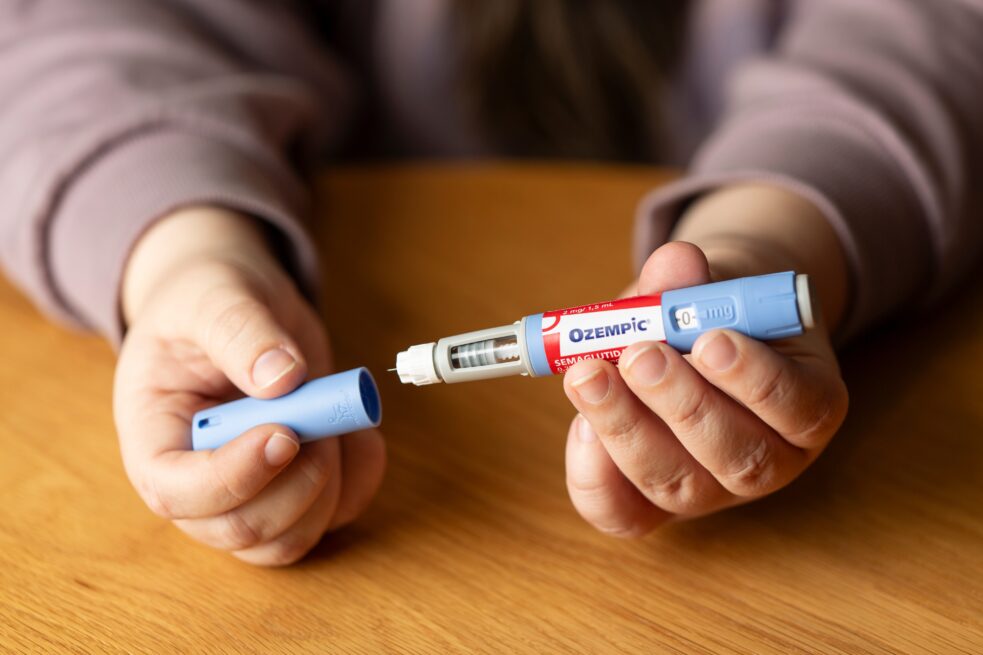A few years ago, hardly anyone had heard of “Ozempic.” Today, it’s practically part of everyday conversation (who hasn’t gotten the jingle “Oh, Oh, Oh, Ozempic” stuck in their head a time or two?). Chances are, you or someone you know has used it or a drug like it. According to the most recent KFF Health Tracking Poll, 12% of American adults have tried a GLP-1 drug.
In many circles, Ozempic has become the catch-all term — like Band-Aid or Xerox — for a selection of drugs called glucagon-like peptide-1 agonists (GLP-1s). Approved by the U.S. Food and Drug Administration (FDA) in 2017 for treating type 2 diabetes (TD2), Ozempic has seen one of the fastest adoption rates in U.S. pharmaceutical history, thanks in large part to its success in also promoting weight loss. Other GLP-1 drugs have followed in its footsteps, including Wegovy (approved for chronic weight management in 2021), Mounjaro (type 2 diabetes in 2023), and Zepbound (chronic weight management in 2023).
GLP-1 drugs differ by their active ingredient: semaglutide in Ozempic and Wegovy and tripeptide in Mounjaro and Zepbound. They’re also different in their FDA-approved uses and dosage. However, all these drugs mimic gut hormones known as incretins. Semaglutide targets GLP-1 receptors only, while tirzepatide targets both GLP-1 and GIP (gastric inhibitory polypeptide) receptors.
“These drugs have a variety of different effects on tissues in the body,” says Alyssa Dominguez, M.D., an endocrinologist in Los Angeles, affiliated with Keck Medicine of USC. “For diabetes and weight loss, they increase the synthesis and secretion of insulin, making the body less resistant to insulin, decreasing appetite, and slowing down gastric emptying.”
Dr. Dominguez says she frequently prescribes GLP-1s, citing a growing body of evidence that not only supports their effectiveness for their intended uses, but also their role in reducing the risk of cardiovascular events and kidney disease. (There is even emerging preclinical evidence suggesting GLP-1s may significantly reduce the risk for first-time Alzheimer’s disease diagnoses.)
The most common side effects Dr. Dominguez says she sees are nausea, constipation, diarrhea, and abdominal pain. In her experience, when patients start taking the drug or increase the dose, they’re likely to experience some digestive issues, but these typically resolve within a few weeks. Less common but more significant consequences can include pancreatitis, gastroparesis, bowel obstruction, gallstones, and bile-duct blockage. (If you’re on a GLP-1 and experience severe vomiting and diarrhea, an inability to move your bowels, or jaundice, it’s essential to tell your doctor ASAP.)
Sarah Linke, senior director of Clinical and Translational Research for Omada Health, a virtual-care program that helps patients manage chronic conditions, says the company started a GLP-1 program in 2023 for patients seeking treatment for obesity. In tracking patient discontinuation of the drug, “we were very surprised,” she says. “We expected side effects to be the primary reason people stopped. Instead, what we saw was most members had stopped not by choice but because they were no longer able to access the drug — either the cost was too high or insurance was no longer covering them.”
Still, side effects of GLP-1s are often highly individualized. To get a sense of what actual patients are experiencing, we spoke with five people of various ages and indications for use who had tried Ozempic or a similar drug. Here are their stories.
Gilbert Fanciullo, M.D., Saranac Lake, New York
Drug: Ozempic and Mounjaro
Indication for use: weight loss and prediabetes
Duration: 7 months on Ozempic, 5 months on Mounjaro; discontinued
Side effects: GERD, severe constipation, and alarming abdominal pain
After struggling with his weight for more than a decade, Dr. Fanciullo, a 74-year-old retired anesthesiologist, was eager to find a solution. He hoped losing about 40 pounds would alleviate his nagging hip pain. Having tried a variety of traditional methods, including Weight Watchers, his family doctor prescribed Ozempic for him.
“I had to pay out of pocket — about $1,000 a month,” Dr. Fanciullo says, “but I wanted to lose the weight.” (Most insurers in the United States only cover Ozempic when prescribed for its FDA-approved use in treating type 2 diabetes.)
Over the seven months he was getting the weekly injections of Ozempic, Dr. Fanciullo dropped more than 30 pounds, but, he says, “the side effects were horrendous.” Severe constipation, constant bloating, worsening GERD (short for gastroesophageal reflux disease), and intense abdominal pain were a daily occurrence. Dr. Fanciullo had a history of gastrointestinal issues, which Ozempic seemed to exacerbate.
“I was a palliative medicine doctor, so I know how to treat constipation — and nothing worked. I felt full all the time and couldn’t sleep lying down. It was really unpleasant,” he recalls.
“Despite the fact that I had lost a lot of weight, I can’t say I was actually feeling better,” he says. He did report the side effects to his doctor, who suggested that increasing his dosage more slowly might help. (The general recommendation is to start with the lowest dose of 0.25 mg once weekly for four weeks, gradually increasing to 0.5 mg for at least four weeks, and continuing to 1 mg, the recommended maintenance dose, for as long as needed.)
Yet even with that, the symptoms persisted. One day, the abdominal pain was so intense that Dr. Fanciullo considered taking himself to the emergency room. Instead, he decided to skip his weekly Ozempic dose. “The very next day, I was feeling better,” he says. Staying off the medication eased his symptoms to the point where they were “completely gone within three or so weeks.”
Despite the challenges, Dr. Fanciullo remained interested in GLP-1 options. After regaining some of the weight he’d lost with Ozempic, which took about two months, his doctor suggested trying Mounjaro (active ingredient, tirzepatide), hopeful that a different drug might offer the benefits without the downside. But within a few months, the same debilitating side effects returned.
For Dr. Fanciullo, the drawbacks of these medications became clear. Still, he doesn’t dismiss their value. “If you don’t develop side effects and you lose 20% to 30% of your body weight, where’s the downside? These drugs are far safer than living with obesity,” he says. Today, Dr. Fanciullo is waiting for the next generation of GLP-1 therapies — ones he hopes his system can tolerate.
“Jill” (not her real name, to protect her privacy)
Drug: Compounded semaglutide
Indication for use: insulin resistance and prediabetes related to PCOS (polycystic ovarian syndrome) and a history of gestational diabetes
Duration: 1+ years, ongoing
Side effects: Mild nausea and sensitivity to cold when increasing dose
For “Jill,” navigating life with an eating disorder had been a decades-long battle. Diagnosed with anorexia as a teenager, she spent years in recovery — eventually working within the eating disorder community. But after a diagnosis of insulin resistance and PCOS, two pregnancies, and a relapse in her forties, Jill found herself trapped in a cycle of constant hunger, weight fluctuations, and blood sugar instability.
“I was doing everything ‘right,’ following recovery protocols and intuitive eating, but I was always hungry,” she recalls. The relentless hunger wasn’t just psychological; it was metabolic. Jill developed prediabetes, gained significant weight, and experienced frequent headaches, shakiness, and fatigue.
Reluctantly, and after much debate with her care team, Jill turned to compounded semaglutide (a version of the medication made by pharmacies or outsourcing facilities). What she feared could trigger disordered behavior became something entirely different: relief. “A week after starting, I sat in my backyard and cried. I felt like the eating disorder was taken out of my brain,” she says. The medication didn’t erase her enjoyment of eating — it restored balance. The constant preoccupation with food, fear of binging, and blood sugar crashes disappeared.
While she says she did experience significant nausea when she tried to increase her monthly dose, Jill says she has been able to mitigate the issue by staying on a relatively low dose. One other adverse reaction she’s noticed is cold sensitivity: “The day after I take the shot, I always get really cold.”
Jill remains private about her use of semaglutide, wary of judgment from those who misunderstand its purpose. “I wish people saw these drugs as metabolic treatments, not just weight-loss tools,” she says. For her, semaglutide has been effective for managing anxiety and compulsive behaviors. (While more research is needed, there are early indicators that semaglutide can affect anxiety — both positively and negatively). “I’d take it forever, even if I hadn’t lost a single pound, because it makes me feel so good.”
Shelly, Cardiff by the Sea, California
Drug: Ozempic
Indication for use: weight loss and prediabetes
Duration: 2+ years, ongoing
Side effects: Mild constipation
“I had been overweight pretty much my whole life,” says Shelly, 64. However, two and a half years ago, after the sudden loss of her husband, Shelly’s health problems spiraled out of control. “I gained 12 pounds within a month after my husband died; I just got sicker and sicker,” she says. As her weight spiked, she faced a series of medical challenges, including high blood pressure, prediabetes, and polymyalgia rheumatica (PMR), an inflammatory condition causing constant muscle and joint pain. “I thought, I’ve got to do something. I can’t even look at myself in the mirror anymore,” she recalls.
Shelly’s general practitioner suggested she try Ozempic, which was covered by her health insurance thanks to her high A1C levels. Over the course of 23 months, Shelly lost 92 pounds by combining Ozempic with a mindful eating approach. “People think you just take the drug and the weight falls off. It doesn’t. You have to put in the effort,” she says.
Share Your Ozempic Story
Have you or someone you know used Ozempic or a similar GLP-1 medication? We want to hear your story. Share your experiences in the Comments or connect with us directly by emailing editorial@medshadow.org or messaging us on Instagram @medshadowfoundation.
Everyone’s journey with these drugs is different, and your insights could help others who are navigating similar experiences. And remember — while personal stories are powerful, medical decisions should always be made with guidance from your healthcare provider.
Along the way, her prediabetes, high blood pressure, and PMR resolved themselves, allowing her to stop multiple medications, including Metoprolol and Losartan (taken for high blood pressure), as well as Kevzara and Prednisone (taken for PMR). Her A1C levels are now in the normal range as well. The only lingering side effect is mild constipation, which she manages with an over-the-counter stool softener.
“I’m probably the picture-perfect model for this drug,” Shelly says. She never experienced serious nausea or fatigue (if anything, her energy has increased). She’s also noticed that the drug has enabled her to reduce alcohol consumption. “I drink probably one-third of what I used to drink,” she says. While Shelly says she never had a drinking problem, studies show that semaglutide can help reduce alcohol cravings in adults with alcohol use disorder.
Even though she plans to experiment with reducing her dose, Shelly says she would consider staying on Ozempic indefinitely. “I’ve heard that people who get off the drug gain the weight back. I just never want to be that heavy again.”
Rana, Moncton, New Brunswick, Canada
Drug: Ozempic
Indication for use: weight loss
Duration: 2 months, first use, 3 months, second use; just started third use
Side effects: Persistent nausea, GERD, fatigue, and depression
Around 2021, Rana, a high school English teacher in her forties, started experiencing high stress levels, which led to rapid weight gain. For the first time in her life, she met the criteria for clinical obesity.
“Teaching after the pandemic was quite stressful. I’ve always been a stress eater, but my appetite was out of control. I was waking up at night just to eat,” she remembers.
Rana tried both depression and anti-anxiety drugs, as well as the supplement Ashwagandha, but wasn’t able to find an option that reduced her stress. Seeking a solution for at least her stress-related eating, Rana’s family doctor prescribed Ozempic, which in Canada was covered by health insurance.
“I was told it was the best drug on the market and that there would be minimal side effects,” she says. Rana began treatment without being advised to adjust her diet. On low doses, she felt fine. But once she increased to 1 mg, side effects hit hard: severe heartburn, persistent nausea, low energy, and an unexpected wave of depression. “It was terrible. I had no desire to do anything. I used to go for walks, but I stopped exercising altogether,” she says. The persistent nausea and feeling of fullness made food and even water unappealing. “I would go for days without eating,” she says. “I started having dehydration headaches and my energy was seriously so low.”
Discouraged by the worsening symptoms — and disappointed by a modest 6-pound weight loss — Rana stopped Ozempic after only a few months. But over the next two years, as her weight continued to climb, she decided to give Ozempic another try — this time, combined with a low-carb diet and a slower approach to increasing her dose.
While she lost 20 pounds on her second attempt, the same pattern of side effects emerged. Once she reached the dose of 1 mg, nausea, dehydration, headaches, and depression returned. “I realized pushing the dose made everything worse. The depression was really bad, and I was like: This is just not worth it.” Rana says she decided to quit cold turkey.
However, after swearing off the drug, Rana had a change of heart when she noticed the weight creeping back over the next few months. She is now a few weeks into her third try with Ozempic and says the experience has been much better thanks to joining an online support group and restricting fried foods, sugar, and processed carbohydrates. “My energy is better and my symptoms are not as bad this time, even though I’m on the 1 mg dose,” Rana says. “I’m also more realistic about my expectations. This is not a magic pill.”
Understanding the Side Effects of GLP-1s
With the ability to successfully lower blood sugar levels and treat obesity—a condition affecting two in five American adults that increases the risk of diabetes, heart disease, certain cancers, and more—it can be tempting to label the GLP-1s a “wonder drug.” However, every medicine has side effects. The first-person stories above highlight how experiences with Ozempic, Mounjarno, et al. can vary widely. While the drugs offer significant benefits for some, others have faced serious physical and mental challenges.
In a small 2022 study of just over 100 patients taking semaglutide for two years, more than half experienced nausea, while more than 30% reported diarrhea, vomiting, or constipation. However, fewer than 4% had gastrointestinal side effects severe enough to stop taking the medication.
“Ozempic has only been on the market for about eight years,” says Dr. Dominguez, “so we don’t have that sort of 30-year data to see if there are some sort of other side effects we should be thinking about.” She notes that there may be serious long-term risks that could be exposed down the line. “The risk of medullary thyroid cancer has been seen in rat studies, but the evidence for humans is more conflicting. There does not seem to be an increased risk in the short term, but we don’t have long-term data.”
Long-term data on drugs like Ozempic is especially important, as research suggests that maintaining its benefits may require lifelong use. One study found that patients who had lost weight taking a semaglutide, on average gained back nearly 70% of the weight after discontinuing use.
Still, Dr. Dominguez says that when she advises patients, she recommends weighing the long-term risks of the drug against the long-term risks of the condition it’s treating. “The most common cause of death in diabetes is cardiovascular disease, and we do have data to show these medications reduce the risk of cardiovascular events,” she says. “They also seem to lower the risk of chronic kidney disease that progresses to dialysis.”
Want more first-person accounts of what it’s really like to live with the side effects of popular medications? Don’t miss Life on SSRIs: The Good, the Bad, and the Complicated.






